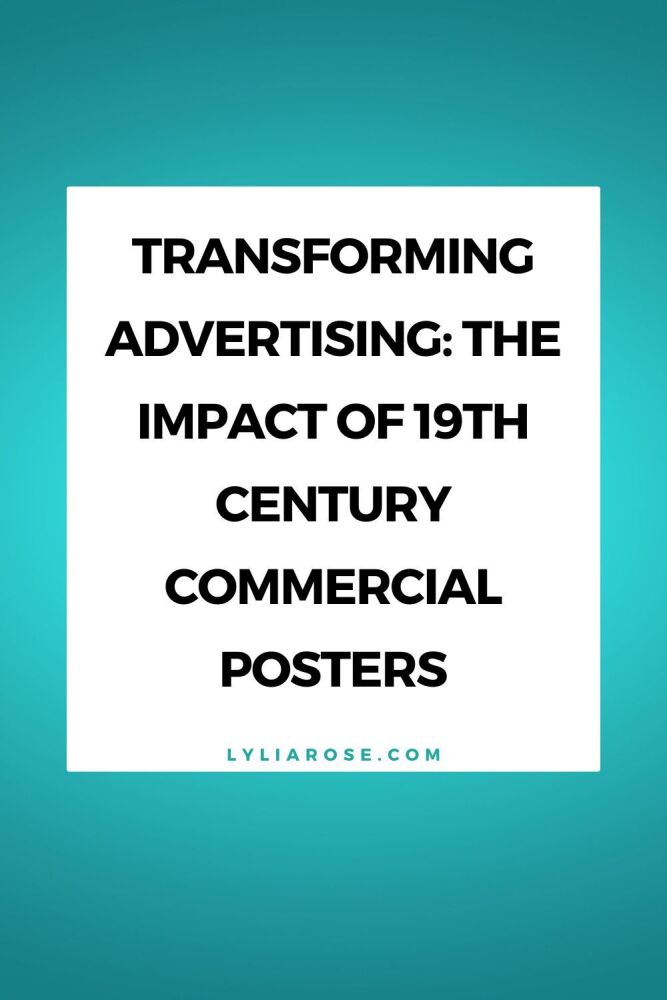Transforming Advertising: The Impact of 19th Century Commercial Posters
Posted on
Explore the transformative impact of 19th-century commercial posters, bridging art and advertising, and discover how their legacy still shapes modern marketing.
The 19th century witnessed a remarkable visual revolution across Europe and America. The rapid surge of industrialisation and mass production created a burgeoning consumer culture. In response, businesses sought innovative ways to captivate their potential customers. This is where commercial posters stepped in, a medium that artfully blended creativity and advertising. Commercial posters captured the public's imagination and transformed the entire marketing landscape.
Amid this visual revolution, the art of poster photo prints gained prominence. These posters featured vibrant photographs that conveyed messages and emotions more effectively than text alone. Photo poster printing became an indispensable tool for businesses, enabling them to showcase new products, announce grand events, and engage their audience in a visually striking manner.
The influence of poster printing extends far beyond the 19th century, continuing to shape modern marketing strategies. While technology and techniques have evolved, the core concept of poster printing remains unchanged. Even in today's digital age, businesses still rely on poster printing to communicate their brand messages, advertise products, and create visually captivating displays. Poster printing is a timeless testament to the enduring power of visual communication in advertising and marketing.
As we delve into the fascinating world of 19th-century commercial posters, we'll uncover how these captivating artworks not only mirrored the evolving consumer culture of their time but also laid the foundation for enduring advertising strategies. Join us on a journey through history as we explore how these posters left an indelible mark on advertising and continue to influence marketing in the digital age.

The Advent of Lithography: A Revolutionary Printing Method
The poster movement gained momentum with the advent of lithography—a printing technique developed in the late 18th Century. Lithography enabled artists to create quality prints boasting details and vibrant colours. This process involved drawing an image on a stone using a grease-based crayon or ink, which was then transferred onto paper.
This innovative printing method enabled the production of large quantities of posters at a reduced cost. It also allowed artists to explore diverse styles and themes, making commercial signs an entirely new art form.
Advertising Transforms into Art
With lithography's arrival, advertisers recognised an opportunity to elevate their messages from announcements to captivating works of art.
During that time, they sought artists who could craft captivating and unforgettable posters that would catch the attention of people passing by.
These artists, who were often trained, eagerly embraced the challenge of merging their creative talents with the demands of commercial advertising. They utilised colours, impactful imagery and clever visual metaphors to produce visually pleasing and persuasive posters.
The Golden Age of Poster Art
The late 19th Century is widely regarded as the Golden Age of Poster Art when iconic poster artists contributed to the field. Renowned individuals such as Jules Chéret, Henri de Toulouse Lautrec and Alphonse Mucha elevated commercial posters into an art form.
Chéret hailed as a pioneer in poster design, bringing elegance to his creations. His expertise in colour usage and artistic composition enabled him to produce posters that effectively promoted various products or events. Chérets groundbreaking techniques inspired generations of artists seeking to push the boundaries of advertising design.
Brand Identity via Posters
During this era, branding began to take hold, with companies realising that a designed and easily recognisable poster could serve as a symbol representing their brand identity.
They began producing posters that prominently showcased their logos and unique visual elements.
This branding strategy helped companies stand out in a market and established a sense of familiarity and trust among consumers. People started associating images and symbols with brands, laying the groundwork for modern advertising and marketing techniques.
From Streets to Art Galleries
As the popularity of posters grew, they started to transcend their purpose as mere advertising tools. Collectors and art enthusiasts recognised the value of these captivating works and began collecting them as art pieces.
The demand for posters as artwork led to their inclusion in exhibitions and galleries. This recognition of the medium further elevated the status of poster artists and solidified the poster's position in art history.
Final thoughts
The emergence of posters during the 19th Century marked a significant shift in both the advertising and art worlds. With lithography on the rise and the introduction of imaginative poster designs, businesses were able to capture consumers' attention like never before. This visual revolution has transformed advertising practices and given birth to a new art form that continues to inspire and captivate audiences.
As we reflect on the enduring legacy of 19th-century commercial posters, it becomes evident that these remarkable creations not only shaped the past but continue to influence the present, reminding us of the timeless power of visual communication in the world of marketing and art.
